Increase Your Creative Thinking Walking the Labyrinth
by Kathryn Bikle as interviewed by Skyler Madison Fontana, PhD
August 20, 2018
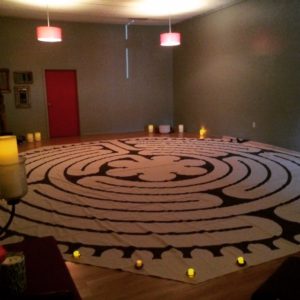
Photo courtesy of Spiral Path Yoga
Recently I was interviewed by creativity and writing specialist Skyler Madison Fontana, PhD. She has been intrigued by studies from researchers at Stanford which show that walking can help increase creative inspiration and divergent thinking. When I told her about my personal growth workshops doing authentic movement and walking the labyrinth, she was excited to discuss how this form of movement meditation might additionally enhance our capacity for creative thinking. You can listen to a podcast of that interview here.
Such an interesting topic! Worth hours of discussion! But live interviews carry the risk that your responses will be less than articulate and/or you’ll forget to say something really important! To that end, I’ve put together a written version of my responses to Skyler’s interview questions that represents a fuller discussion of the topic than what we had time for in the live interview. What follows is that fuller discussion:
SMF: Walking has been shown to help increase creative inspiration and divergent thinking. This is something that can benefit writers. How might a meditative practice that includes walking the labyrinth increase our capacity for creative thinking? How is it different than plain walking? Does it provide an enhanced experience? Maybe you could start by telling us a little bit about the origins of the ancient meditative practice of walking a labyrinth.
KB: The Labyrinth is an archetypal symbol dating back more than 4,000 years which is found in almost every ancient culture world-wide; from Greece and Crete, to Egypt, China, Peru, Ireland, Scandinavia, and even among Native American tribes. The oldest European Labyrinth on record is from Crete. And despite the isolation of early civilizations from one another, over thousands of years only one archetypal design emerged.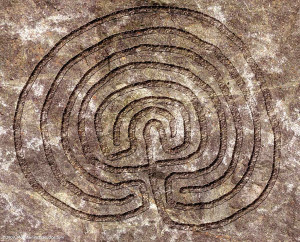
The Labyrinth’s vortex spiral pattern is a part of almost every religious tradition around the world. Its origins are unknown. However, there is some speculation that the pattern for the earliest labyrinths is based on the physical shape of the brain (as looking down on the top of the head with the skull removed) or more probably, the intestines. Ancient peoples thought the intestines were the uterus, and so spiritual rituals centered around the theme of life/death/rebirth, involved walking the Labyrinth’s spiral path to the center as a journey of dissolution into the cosmic womb, joining with the Divine Mother at the center, and returning back out to the world as a symbol of spiritual rebirth.
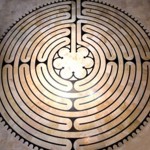 In the Middle Ages, Christians were expected to travel to the Holy Land at least once during their lifetime. During the Crusades, travel became too dangerous, and so certain cathedrals throughout Europe were designated as “pilgrimage cathedrals”. Here, at these cathedrals, Christians would walk the labyrinth as a spiritual metaphor for making the physical journey to Jerusalem. You can see remnants of some of these labyrinths even today. The one at Chartres Cathedral in France is one of the most recognizable Labyrinth patterns from the Medieval era. When I offer my Embodied Labyrinth workshops, I use a modified version of the original Chartres Cathedral labyrinth, painted on canvas, for the participants to walk.
In the Middle Ages, Christians were expected to travel to the Holy Land at least once during their lifetime. During the Crusades, travel became too dangerous, and so certain cathedrals throughout Europe were designated as “pilgrimage cathedrals”. Here, at these cathedrals, Christians would walk the labyrinth as a spiritual metaphor for making the physical journey to Jerusalem. You can see remnants of some of these labyrinths even today. The one at Chartres Cathedral in France is one of the most recognizable Labyrinth patterns from the Medieval era. When I offer my Embodied Labyrinth workshops, I use a modified version of the original Chartres Cathedral labyrinth, painted on canvas, for the participants to walk.
SMF: It is based on sacred geometry how does that factor into it?
 KB: Sacred geometry is the study of fundamental patterns, structures, principles and processes that are at the foundation of reality and based in mathematical relationships and form. Sacred geometry can be found in all of nature in golden mean proportions, Fibonacci spirals, hexagonal structures, crystal structures, fractals, etc. We can see these patterns, structures and processes on the macro and micro scale throughout the universe. For example, the vortex spiral – which is the fundamental pattern of the Labyrinth – is clearly present in galaxies, the gas clouds of planets, in our own clouds and the oceans of Earth, in hurricanes, tornadoes, — in your sink as the water drains. You can see on a smaller scale in the growth patterns of flowers, or shells. And, these same patterns are also present at the micro scale in cells, DNA molecules, and in atomic structures.
KB: Sacred geometry is the study of fundamental patterns, structures, principles and processes that are at the foundation of reality and based in mathematical relationships and form. Sacred geometry can be found in all of nature in golden mean proportions, Fibonacci spirals, hexagonal structures, crystal structures, fractals, etc. We can see these patterns, structures and processes on the macro and micro scale throughout the universe. For example, the vortex spiral – which is the fundamental pattern of the Labyrinth – is clearly present in galaxies, the gas clouds of planets, in our own clouds and the oceans of Earth, in hurricanes, tornadoes, — in your sink as the water drains. You can see on a smaller scale in the growth patterns of flowers, or shells. And, these same patterns are also present at the micro scale in cells, DNA molecules, and in atomic structures.
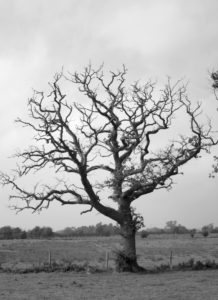 Surroundings which include structures and processes reflective of Sacred Geometry, whether naturally present in Nature or articulated in man-made architectural forms, create a balanced and serene climate for the human psyche and soul. It creates an environment that the mind finds peaceful, harmonious, and allows it to attain other levels of awareness. These other levels of awareness help us to tune into the unconscious and the needs of the inner self. This draws us into a more authentic relationship with what the Psyche needs in order to grow in a healthy direction.
Surroundings which include structures and processes reflective of Sacred Geometry, whether naturally present in Nature or articulated in man-made architectural forms, create a balanced and serene climate for the human psyche and soul. It creates an environment that the mind finds peaceful, harmonious, and allows it to attain other levels of awareness. These other levels of awareness help us to tune into the unconscious and the needs of the inner self. This draws us into a more authentic relationship with what the Psyche needs in order to grow in a healthy direction.
SMF: Can you say more about how walking the labyrinth achieves this?
KB: The Labyrinth’s vortex spiral path turns clockwise, cleansing and quieting our minds as it leads in; and its counterclockwise unwinding path leading us out, integrates and empowers.
The Medieval Chartres Cathedral style Labyrinth which I often use for my workshops has several added benefits which intensify one’s experience: It was designed using additional layers of Sacred Geometry: An invisible 13-pointed star, and the Flower of Life at the center. It also includes symbols of the Divine and of the Feminine, including a Rose/Lotus/Sun at its center which is a universal symbol of Enlightenment, the Self, and wholeness; Labyrs, which are the double-headed ax symbols built into the design which remind us of feminine roots of the ancient Minoan Goddess religion, and the lunations around the outside are symbols of phases of the moon, again, a symbol of the feminine.
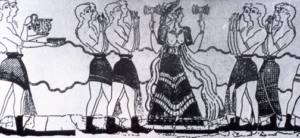
SMF: How does one go about doing it, what does it involve? Describe it for us.
KB: It’s very simple, actually. First, there are no rules: only suggestions:
Set an intention for yourself: a question about something or a relationship to something or someone you would like to explore (It’s best if this is left a bit open-ended); Or, you could allow yourself to enter with a blank mind and let any images that present themselves as you proceed be your topic. Another possibility is to simply walk the Labyrinth as a physical, nervous system balancing experience (this is the purpose behind labyrinths being present in many schools, parks, and hospitals where they are painted or built onto their grounds).
Before you enter, you may wish to pause at the entrance and become aware of your breath. You may like to consider that in entering the labyrinth you are entering sacred space. So, if you would like to mark this threshold with a gesture or phrase that is totally appropriate.
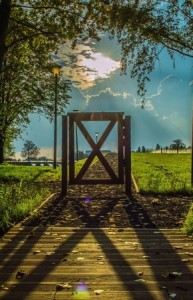
You can walk at any speed that feels comfortable to you. Others may be walking the labyrinth as well, a few steps ahead or behind. Don’t let their pace influence yours. Let them pass you if you want to go slow. Or pass them if you want to move more quickly. You don’t need to make eye contact with the others unless you want to. When you get to the center, you are welcome to sit, stand, etc. as long as you like. In the Chartres style labyrinth, there are petals on the Rose in the center that you can sit or stand in. Stay in the center as long as you like. When you leave the center, you simply follow the same path you took in.
When you conclude your journey, you may wish to turn around at the entrance/exit and honor the Labyrinth with a bow, or repeat gesture indicating you are leaving sacred space. But you don’t have to. You can simply walk out.
The Three-Fold path of the Labyrinth Meditation Walk
- Release – Let go of details of your everyday life, quieting the rational mind, beginning the process of opening to your intuition, your Muse, higher Self, and deeper knowing from the Unconscious. (palms down)
- Receive – As you reach and spend time in the center, you may feel calm, recognize an insight, or, clarity about the topic of your intention. This is a place of openness to your intuition, Muse, higher Self, wisdom of the Unconscious, and the body. Consider that your insights, etc. may come in the form of sensations, feelings, images, sounds, etc. and not necessarily in full sentences from an unknown booming voice in your head. Receive whatever is there for you to receive. (palms up)
- Return – As you follow the path out from the center you begin the process of integrating your new insights into your conscious awareness. You may feel a deep sense of empowerment, focus, and balance as your rational mind begins to include the inner wisdom of the unconscious (muse) with the goals and intentions of your everyday world (goals of your project). (Labirnth facts and ritual sue thanks to Lauren Artress, author of “Walking a Sacred Path” and Veriditas.org)
SMF: What would you say are the main benefits, and why?
 In walking the Labyrinth there is only one path. We follow one path in and the same path out. There are the same number of turns to the right as to the left – activating both sides of the brain in a physical experience. This engages both left and right sides of the brain. It invites our pattern-seeking (right brain) as well as our symbolic mind (left brain) to come forth. This creates a balanced sense of harmony while opening us to our creativity and deeper knowing. It reinforces integration of both right and left brain. And it instills a sense of calm, serenity, clarity of mind, and if we intend it, a deeper understanding of the issue we have come to seek clarity on and our purpose in that regard.
In walking the Labyrinth there is only one path. We follow one path in and the same path out. There are the same number of turns to the right as to the left – activating both sides of the brain in a physical experience. This engages both left and right sides of the brain. It invites our pattern-seeking (right brain) as well as our symbolic mind (left brain) to come forth. This creates a balanced sense of harmony while opening us to our creativity and deeper knowing. It reinforces integration of both right and left brain. And it instills a sense of calm, serenity, clarity of mind, and if we intend it, a deeper understanding of the issue we have come to seek clarity on and our purpose in that regard.
So, one major benefit of using the labyrinth for creative or personal growth work is that it is a model that establishes a movement towards wholeness and integration while activating us to access our creativity and inner wisdom in a focused, time-limited experience that encourages us to conceive a question, goal, or intention, and open to influences that are greater than our usual everyday awareness. Then, structurally, on the return journey out, we begin the process of integrating these new perspectives into a form that we can understand with our rational mind and make use of in our everyday world.
When we use the labyrinth as a means of personal goal setting, we open to the unconscious, to our inner wisdom, in our exploration of how we might better understand our relationship to that goal. In so doing, our insights into how we now can, with this new deeper understanding, move towards achieving this goal, will be in alignment with the needs of the Psyche. This makes it far more likely that we will be successful in achieving our goals and be less susceptible to self-sabotage.
SMF: How is it different than mindful walking?
In mindful walking our intention is often on calming the nervous system in order to be more fully present in our bodies in the present moment. This is a good thing! The Labyrinth does this too, but by engaging the right and left brain equally in following equal number of right and left turns in the Labyrinth, we also are opening ourselves up to a focused engagement with our creativity and deeper knowing. Because of the circuitous way in which the Labyrinth’s path unfolds, sometimes leading us closer to the center, sometimes farther away, — we can always see our goal (the center, or the exit) but we may not be able to see exactly how we are going to get there. In fact, we may feel confused at points, and feel like we have lost our way. This “feeling lost” experience has the effect of un-mooring us from our rational processes and opens us more fully to our non-linear thinking and creative problem-solving abilities. But we know rationally, and trust implicitly that we can’t actually get lost! Such trust in knowing we are safe regardless of our feelings, allows us to immerse ourselves in our irrational mindset without fear. This further opens us to our creativity and inner wisdom. An obvious difference between walking the labyrinth and a walking meditation in the outside world is that outside, you might actually have to pay attention to where you are walking so you don’t get run into by a bicycle or step in something unpleasant.

SMF: In what way can it lead to gaining more inner wisdom, as a doorway to the Self?
 Jungian psychologists hold that the Psyche (and the deeper wisdom of the Mind/Body) knows what it needs to heal the wounds of the Ego-self and what it needs in order to grow towards wholeness and a fuller development of the higher Self. (This process is never finished, by the way. We can take the opportunity to continue to work on our personal development until the day we die!) Messages pointing towards what the Psyche needs in order to grow/heal come in the form of images from the unconscious, in dreams, day dreams, thoughts, body sensations, etc. such that any work of art or creativity that we engage in – and by this I include science, math, and engineering, STEM subjects, not just ART – any work of creativity that we engage in offers us the opportunity to grow our Self in a way that is consistent with our inner values and search for wholeness, fulfillment and meaning.
Jungian psychologists hold that the Psyche (and the deeper wisdom of the Mind/Body) knows what it needs to heal the wounds of the Ego-self and what it needs in order to grow towards wholeness and a fuller development of the higher Self. (This process is never finished, by the way. We can take the opportunity to continue to work on our personal development until the day we die!) Messages pointing towards what the Psyche needs in order to grow/heal come in the form of images from the unconscious, in dreams, day dreams, thoughts, body sensations, etc. such that any work of art or creativity that we engage in – and by this I include science, math, and engineering, STEM subjects, not just ART – any work of creativity that we engage in offers us the opportunity to grow our Self in a way that is consistent with our inner values and search for wholeness, fulfillment and meaning.
SMF: How can it be used by writers who want to gain insights?
Writers are often encouraged to “write what they know.” This is important because the reader then experiences a world that feels true; authentic of the individual experience of the writer. At the same time, writers want to create characters and stories that appeal to a wider audience than people just like them. So, it’s important for writers to be able to tap into aspects of their characters and stories which resonate with the themes and archetypes of the collective. Of myth. This makes the journey of this hero whom they are writing about, a story many people can relate to, even in different cultures. So, by engaging one’s own access to the wisdom of the collective unconscious – by walking the labyrinth or whatever) we invest the archetypes of the collective unconscious with the individuality of our own creativity and create an authentic feeling story in which others are able to see themselves even if their actual circumstances are very different.
SMF: What about setting intentions, asking for guidance… how would that benefit a writer?
When writers choose to focus on deeply understanding one character or one aspect of the story they want to tell, the entire enterprise is deepened, authenticated. “A high tide raises all boats,” as they say. By consciously engaging the  deeper wisdom of the Psyche in the process of creating or problem solving, we are doing just that: deepening our work in alignment with what is universally true for all human experience. When we ask our deeper knowing for guidance we always receive an answer. We simply need to be aware that sometimes the answers are not completely spelled out for us and we may have to do some additional digging or exploring in order to understand Psyche’s messages more fully. Like, from images (in dreams or day dreams), feelings, intuitions, or physical sensations. All of these are legitimate sources of expression for Psyche’s wisdom to come forth. We may need to tease apart the meaning of a particular image, sit with uncomfortable or contradictory truths, and trust that the deeper meaning will come to us when we are ready to listen. When we choose to listen to our inner wisdom, as crazy as it sometimes may appear, we are validating our own authentic voice and our own, deeply authentic creative gifts. I think that is of great benefit to a writer. ※
deeper wisdom of the Psyche in the process of creating or problem solving, we are doing just that: deepening our work in alignment with what is universally true for all human experience. When we ask our deeper knowing for guidance we always receive an answer. We simply need to be aware that sometimes the answers are not completely spelled out for us and we may have to do some additional digging or exploring in order to understand Psyche’s messages more fully. Like, from images (in dreams or day dreams), feelings, intuitions, or physical sensations. All of these are legitimate sources of expression for Psyche’s wisdom to come forth. We may need to tease apart the meaning of a particular image, sit with uncomfortable or contradictory truths, and trust that the deeper meaning will come to us when we are ready to listen. When we choose to listen to our inner wisdom, as crazy as it sometimes may appear, we are validating our own authentic voice and our own, deeply authentic creative gifts. I think that is of great benefit to a writer. ※
Upcoming Workshops:
Autumn Equinox Labyrinth workshop 9/23/18 at Monrovia Canyon Park Cabin
Led by Kathryn Bikle, LMFT, Labyrinth Facilitator, Sponsored by The Place Within
Session 1 for Mental Health Professionals, 3.0 hrs CE credit 9-12pm
Session 2 for General Public 1-4 pm
Details and registration information at www.theplacewithin.org/training.html
Creative Writer’s Journey workshop 5/11/19 at Serra Retreat Center in Malibu
Led by Skyler Madison Fontana, PhD
Opening writers to their creativity and enhancing the development of their unique voices
See http://skylermadison.com/story-workshop/ for registration and details
 (626) 755-6437
(626) 755-6437
